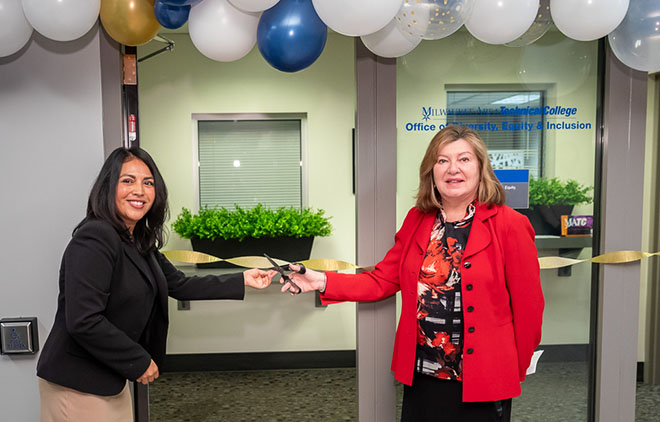The strategic plan at Milwaukee Area Technical College (MATC) has focused on breaking down barriers that stand between students and their academic and career success. One key strategy to break down these barriers has been the development and implementation of the college’s inaugural diversity, equity and inclusion (DEI) plan, which has been successful in part because of the foundation built over two years among the college’s leadership, faculty, staff, students and an engaged district board.

“DEI initiatives are of paramount importance to us,” said MATC President Vicki J. Martin. “We are one of the most diverse two-year colleges in the Midwest, so our DEI efforts truly affect our students, our staff and our community. For all of them, we need to get this right.”
The college started seeing results in 2020, where 55.1% of MATC’s nearly 30,000 students identified as racially diverse, including 25.9% as Black and African American and 19.3% as Hispanic. Among faculty, 31.3% identified as racially diverse.
This article is part of a monthly series provided by the National Council for Marketing & Public Relations (NCMPR), an affiliated council of the American Association of Community Colleges.
That same year, equity became one of the top four priorities in the college’s five-year strategic plan to ensure it stayed focused on this, and the college identified inclusion as a value.
“As the landscape of higher education continues to change, equity and inclusion must become a way of life and part of our DNA,” Martin said. “DEI must be embedded within and throughout the district we serve because that is what our mission and values call us to do.”
Building momentum
In April 2021, the college appointed Eva Martinez Powless as its first DEI officer, reporting directly to the president. For Powless, DEI is highly personal: She came to the U.S. as an immigrant when she was 12. She was a single mother at 18 and had to work full-time while attending college. Eventually, she became the first person in her family to earn a bachelor’s degree, a master’s degree and recently a doctorate.
In June 2021, the college formed the President’s Diversity, Equity and Inclusion Task Force to develop a long-range DEI plan. The group met with large and small groups and collected feedback from employees, students and community groups.
The task force completed in summer 2022, and MATC unveiled a five-year plan to improve the college’s DEI climate and experience for employees and students. The plan had four goals: to make MATC a welcoming, inclusive community; a diverse community; an equitable community; and an anti-racist community.

The college opened a centralized DEI office in October 2022. The space includes a small lobby, several offices and cubicles, a sitting area and a conference room. The college’s deputy Title IX coordinator and equity officer has space there, as well as the DEI coordinator, student employees and staff members working on the college’s Hispanic-serving institution initiative.
“It’s important that we have a central location, a center, a hub, where all students and staff can feel included and a sense of belonging at any time,” Powless said. “We received support and leadership from many people to make this happen, especially from the president’s council and cabinet.”
A solid foundation
This spring, Powless hosted a series of lunch-and-learn sessions at MATC’s five campus areas, providing an open forum to discuss the college’s on-going DEI efforts. The college also:
- Recognized diversity and inclusion champions and strongly encouraged administrators, faculty and staff to become DEI certified.
- Developed employee affinity groups dedicated to supporting equity and inclusion values by building community, promoting a sense of belonging, supporting student success, and assisting in the recruitment and retention of diverse talent. Specific groups included African American women; Asian people; Black, Indigenous and people of color; Latinx people; and LGBTQ+ people and their allies.
- Created an equity dashboard to both monitor data on racially diverse students, faculty and staff and also measure graduation, retention and persistence among students.
- Hired the first chairperson of social justice to find creative, engaging ways to illuminate and discuss DEI issues on campus and in the community.
Together, these actions and accomplishments have provided a solid groundwork to make MATC more diverse and more welcoming. By the end 2022, the percentage of students identifying as racially diverse had risen to more than 56%, and the percentage of racially diverse faculty rose to 44.3%, Powless said. Employees of color reported having good experiences as measured by the PACE Climate Survey for Community Colleges, which is run by North Carolina State University.
“Our goal is to make MATC a premier diverse and inclusive college,” she said. “This won’t happen overnight. This is an evergreen process because people, processes and policies are ever-evolving. We are always striving to do more.”





